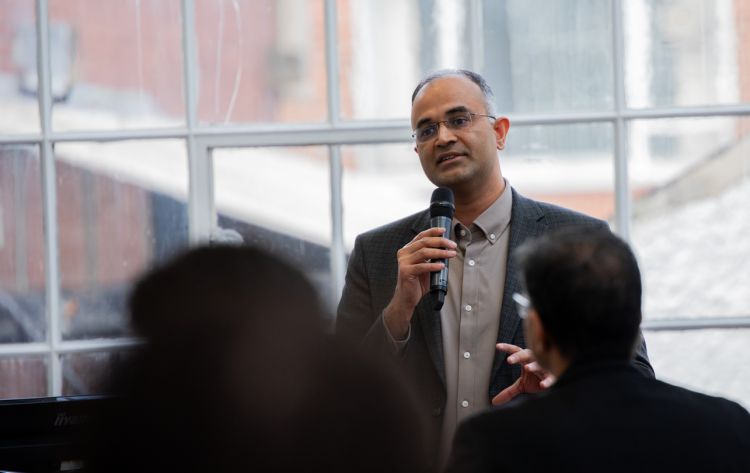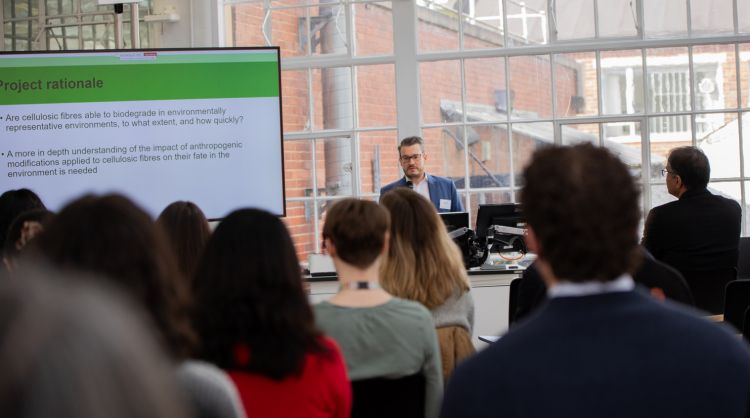Fragmented fibre research to tackle microplastic pollution from textiles

Research at the School of Design, University of Leeds has centred on mechanisms to increase the awareness of Fragmented Fibre pollution among consumers
Microplastics have been detected in all aquatic habitats, from deep oceans to polar ice melt and can be found in the guts and tissues of aquatic animals. Textiles are reported to be 3rd largest source of microplastics in the aquatic environment. All textiles (natural, regenerated, synthetic) release fragments hence the term Fragmented Fibres is used.
Buoyed up by the drive to seek solutions to these challenges, , while also helping the textile/related industry to gauge the impact of their existing products and develop innovative alternatives.
As recipients of an Engineering and Physical Sciences Research Council (EPSRC) funded research grant (EP/T025542/15), the research team from the School of Design consisted of Muhammad Tausif, Professor of Sustainable Textile Manufacturing, Dr. Abdul Jabbar, a research fellow also specialising in Sustainable Textile Manufacturing, and Alma Palacios-Marín, a third-year postgraduate researcher, each based at the University of Leeds, who worked collaboratively with the University of Edinburgh, Gap Inc. The Microfibre Consortium and the Leeds Institute of Textiles and Colour (LITAC) across a 4-year project.

Any remedial measures are challenging given the ubiquity of fibrous microplastics from textiles. Improved plastics with reduced environmental impact, plastic recycling and reduced consumption are extremely important but the release of fibrous microplastics from textiles remains a challenge. The project addressed the challenge by bringing together textile technology, computational modelling and tribology disciplines into a systematic programme of research. The project took both experimental and computational approaches to elucidate fibre damage that leads to the generation of fibrous microplastics and use predictive computational modelling to understand the mechanical behaviour of textile structures. The project also shaped new interdisciplinary collaboration between textile technology and tribology. Furthermore, the project established collaboration with Pontifical Catholic University of Chile for the novel use of Particle Image Velocimetry to elucidate the release of fragmented fibres in aquatic conditions.
The project has already published following peer-reviewed outputs to address the knowledge gaps in the area. There were also invited presentations and a podcast to share the findings with the wider scientific community.
- Jabbar, A., Zhang, H., Yang, D., Evans, E., & Tausif, M. (2025). Micro-computed tomography analysis of ring, rotor, and air jet yarn structures and their impact on fragmented fibres release from polyester textiles. Nondestructive Testing and Evaluation, 1–22. https://doi.org/10.1080/10589759.2025.2482868
- Image-based finite element modelling of fibre dynamics in polyester staple spun yarns. Zhang, H. Jabbar, A. Li, A. Wang, X. Yang, D. Tausif, M. Composites Science and Technology 2025.
- Jabbar, A., Bryant, M., Armitage, J. and Tausif, M., 2024. Oxygen plasma treatment to mitigate the shedding of fragmented fibres (microplastics) from polyester textiles. Cleaner Engineering and Technology, p.100851.
- Dongze Wang, Abdul Jabbar, Edona Hyla, Muhammad Tausif, Michael Bryant, Greg de Boer. BEM-Based Model for Wear in the Contact of Textile Fibres. 49th Leeds-Lyon Symposium on Tribology – September 2-4, 2024, Lyon, France 50 years of Leeds-Lyon.
- Jabbar A, Tausif M. Investigation of ring, airjet and rotor spun yarn structures on the fragmented fibers (microplastics) released from polyester textiles during laundering. Textile Research Journal. https://doi.org/10.1177/0040517523119178.
- Jabbar A, Palacios-Marín AV, Ghanbarzadeh A, Yang D, Tausif M. Impact of conventional and modified ring-spun yarn structures on the generation and release of fragmented fibers (microfibers) during abrasive wear and laundering. Textile Research Journal. 2022;0(0). doi:10.1177/00405175221127709
- Palacios-Marín, A. V., Jabbar, A., & Tausif, M. (2022). Fragmented fiber pollution from common textile materials and structures during laundry. Textile Research Journal, 92(13-14), 2265-2275.
- Alma V. Palacios-Marín & Muhammad Tausif (2021) Fragmented fibre (including microplastic) pollution from textiles, Textile Progress, 53:3, 123-182, DOI: 10.1080/00405167.2022.2066913
The project has ended but the ongoing research and collaborations continue in this area to answers key questions and to develop new interdisciplinary approaches to address the challenge of Fragmented Fibre pollution.
Sharing findings at the inaugural Fragmented Fibres Symposium
Following the completion of the project, the inaugural Fragmented Fibres (including Microplastics) Symposium took place at the School of Design - University of Leeds in March 2025, showcasing the exciting project outputs.

Professor Muhammad Tausif, Principal Investigator of the research project, and Symposium lead, said:
“Fragmented Fibres Symposium disseminated cutting-edge research held at the School of Design/Leeds Institute of Textiles & Colour for nearly a decade on how to quantify, elucidate the generation and release, and combat fragmented fibre pollution.
“The symposium highlighted our interdisciplinary collaborations with designers, engineers, environmental scientists and the textile industry to address key knowledge gaps. It also set the agenda for the future research in the field reinforcing need for continued interdisciplinary collaboration, and the importance of at-source solutions to combat fragmented fibres.”
Dr Abdul Jabbar and Alma Palacios-Marín began the symposium with an in-depth exploration of the how textile structures can contribute to microplastic release. The findings revealed that specific fabric design and engineering, such as the use of flat filament yarns, which possess higher bending rigidity and, therefore, do not absorb mechanical stress, do indeed contribute to the fragmentation of fibres. Wet processes like dyeing and finishing were identified as stages during which fragmented fibres are released, a result of prior fragmentation during earlier manufacturing steps. The study also indicated that modification of fibre surface properties by oxygen plasma treatment reduces the release of fragmented fibres.
Alice Hazlehurst explored the quantification of fragmented fibres by examining the methodologies employed to assess the extent of microplastic pollution in aquatic ecosystems. This session underscored the difficulties inherent in tracking these fibres and the absence of standardised approaches for their quantification. For example, discrepancies in reported fragmented fibres for different fabrics, mainly due to the varied methodologies and differing approaches problematise data analysis. Alice therefore shone a light on how the collection of material loss from fabrics under laundering test conditions can help achieve comparable and accurate results.
Elliot Bland, representing The Microfibre Consortium, followed with a presentation on trends derived from the Database of Industrial Testing, offering valuable insights into the most recent data obtained from the rigorous testing of textile products. His findings illustrated the steps the textile industry is taking to address microplastic concerns, particularly regarding efforts to reduce fibre release from textile goods – for example, stressing the increasing impact of finishing on fibre fragmentation.
Professor Richard Blackburn, reflected on the biodegradation of cellulosic fibres, while highlighting that natural fibres undergo extensive chemical treatment during processing which makes signficant changes to their inherent properties. Instead, citing the research project performed by LITAC-funded PhD researcher, Olivia Skilbeck, titled ‘The impact of preparation, dyeing and finishing treatments on the biodegradation of cellulosic microfibres,’ Blackburn reported that preliminary results show that natural fibres do not behave in “natural ways” as they are affected by processing.
A panel discussion, moderated by Professor Tausif brought together Professor Tamara Galloway (University of Exeter), Elliot Bland, Dr. Mark Taylor, Research Fellow in Fashion Technology at the School of Design, University of Leeds, Paul Kay, Professor of Water Science in the School of Geography, University of Leeds. They engaged in an expert discussion on the future of textile waste management, the challenges of reducing microplastic release, and the importance of cross-industry collaboration.
Dr Haoqi Zhang of Sun Yat-sen University, Dongze Wang, and Dr. Gregory DeBoer, of the School of Mechanical Engineering at the University of Leeds and Dr. Dongmin Yang, Senior Lecturer in Composite Materials at the University of Edinburgh, presented on Modelling (FEM/BEM) Approaches to Model Textile Properties. They introduced sophisticated computational techniques to understand and predict the behaviour of textile materials in real-world environments. Their discussion showed how digital models could simulate the release of fibres and provide insights into how textiles interact with the environment.
Finally, Ángel Palacios Marín from the Pontifical Catholic University of Chile presented on Particle Image Velocimetry, and how as a technique, it can used to better analyse the release of fragmented fibres in aquatic systems. His work highlighted the complex dynamics of fibre release and its potential to inform future research into textile design and waste management.
Next steps for Fragmented Fibre Research
Feedback from the Symposium continued to exemplify the University of Leeds’ status as world-leaders in fragmented fibre research and how best to understand and tackle microplastic release.
The research team is confident that the momentum gained from the event will continue to empower textile manufacturers and finishers to both identify and subsequently develop textiles with reduced FF impacts. This will represent a competitive advantage for both UK and global apparel retailers, allowing them to provide high-quality clothing free with reduced FF pollution. It will also enhance the brand reputation of apparel retailers and provide cost-efficient options for environmentally conscious consumers to purchase clothing with a reduced environmental footprint.
Once again, the research team would like to thank the EPSRC for enabling the project and aim to continue to research mechanisms to stop the release of fibrous microplastics from textiles.




